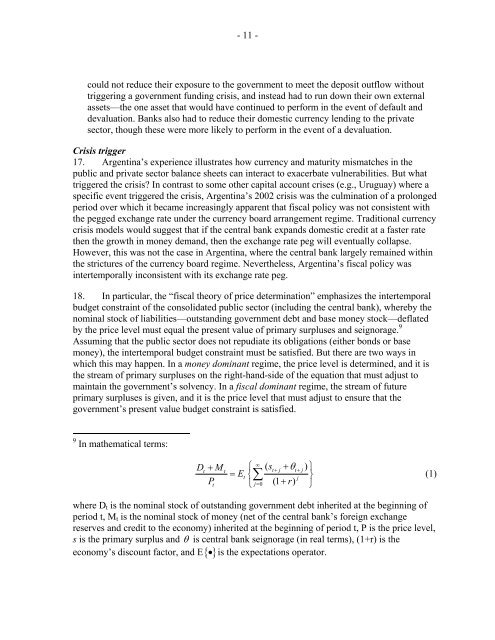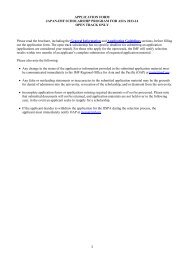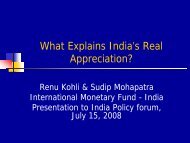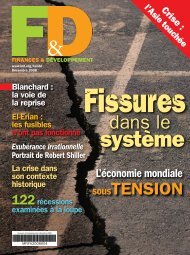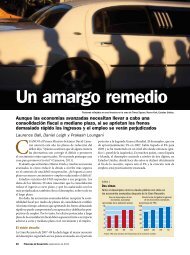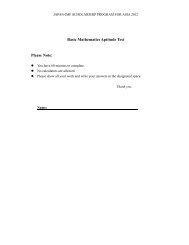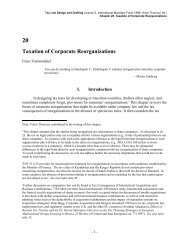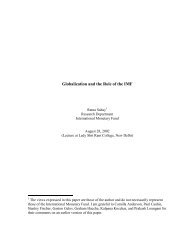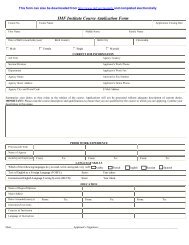Overview of Capital Account Crisis - IMF
Overview of Capital Account Crisis - IMF
Overview of Capital Account Crisis - IMF
Create successful ePaper yourself
Turn your PDF publications into a flip-book with our unique Google optimized e-Paper software.
- 11 -<br />
could not reduce their exposure to the government to meet the deposit outflow without<br />
triggering a government funding crisis, and instead had to run down their own external<br />
assets—the one asset that would have continued to perform in the event <strong>of</strong> default and<br />
devaluation. Banks also had to reduce their domestic currency lending to the private<br />
sector, though these were more likely to perform in the event <strong>of</strong> a devaluation.<br />
<strong>Crisis</strong> trigger<br />
17. Argentina’s experience illustrates how currency and maturity mismatches in the<br />
public and private sector balance sheets can interact to exacerbate vulnerabilities. But what<br />
triggered the crisis? In contrast to some other capital account crises (e.g., Uruguay) where a<br />
specific event triggered the crisis, Argentina’s 2002 crisis was the culmination <strong>of</strong> a prolonged<br />
period over which it became increasingly apparent that fiscal policy was not consistent with<br />
the pegged exchange rate under the currency board arrangement regime. Traditional currency<br />
crisis models would suggest that if the central bank expands domestic credit at a faster rate<br />
then the growth in money demand, then the exchange rate peg will eventually collapse.<br />
However, this was not the case in Argentina, where the central bank largely remained within<br />
the strictures <strong>of</strong> the currency board regime. Nevertheless, Argentina’s fiscal policy was<br />
intertemporally inconsistent with its exchange rate peg.<br />
18. In particular, the “fiscal theory <strong>of</strong> price determination” emphasizes the intertemporal<br />
budget constraint <strong>of</strong> the consolidated public sector (including the central bank), whereby the<br />
nominal stock <strong>of</strong> liabilities—outstanding government debt and base money stock—deflated<br />
by the price level must equal the present value <strong>of</strong> primary surpluses and seignorage. 9<br />
Assuming that the public sector does not repudiate its obligations (either bonds or base<br />
money), the intertemporal budget constraint must be satisfied. But there are two ways in<br />
which this may happen. In a money dominant regime, the price level is determined, and it is<br />
the stream <strong>of</strong> primary surpluses on the right-hand-side <strong>of</strong> the equation that must adjust to<br />
maintain the government’s solvency. In a fiscal dominant regime, the stream <strong>of</strong> future<br />
primary surpluses is given, and it is the price level that must adjust to ensure that the<br />
government’s present value budget constraint is satisfied.<br />
9 In mathematical terms:<br />
∞<br />
D ( )<br />
t<br />
+ M ⎧ s<br />
t<br />
t+ j<br />
+ θt+<br />
j ⎫<br />
= E<br />
t ⎨∑ j ⎬<br />
(1)<br />
Pt<br />
⎩ j=<br />
0 (1 + r)<br />
⎭<br />
where D t is the nominal stock <strong>of</strong> outstanding government debt inherited at the beginning <strong>of</strong><br />
period t, M t is the nominal stock <strong>of</strong> money (net <strong>of</strong> the central bank’s foreign exchange<br />
reserves and credit to the economy) inherited at the beginning <strong>of</strong> period t, P is the price level,<br />
s is the primary surplus and θ is central bank seignorage (in real terms), (1+r) is the<br />
economy’s discount factor, and E{ •}<br />
is the expectations operator.


